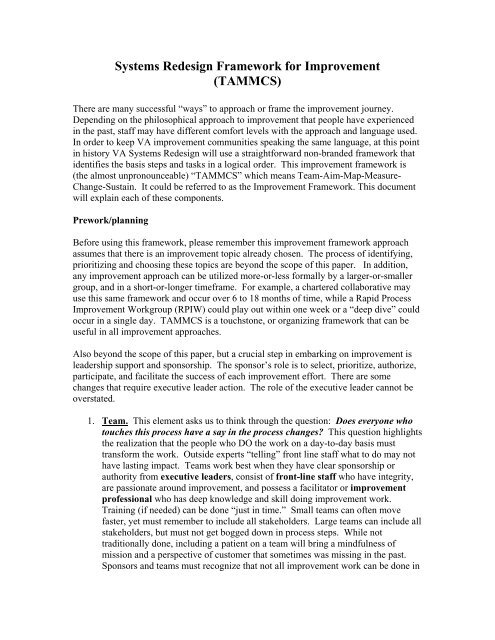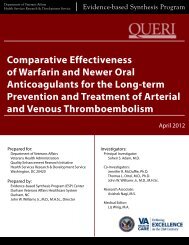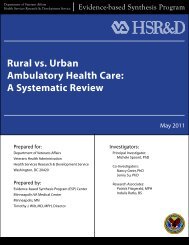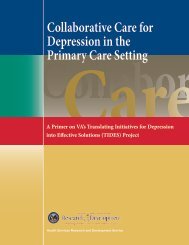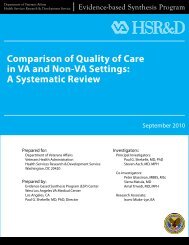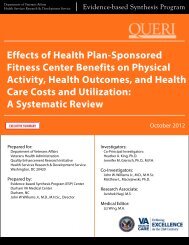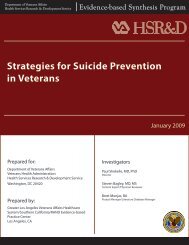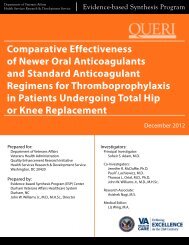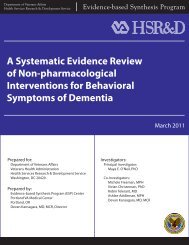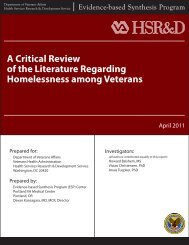VHA Systems Redesign; Transformational change in health care ...
VHA Systems Redesign; Transformational change in health care ...
VHA Systems Redesign; Transformational change in health care ...
Create successful ePaper yourself
Turn your PDF publications into a flip-book with our unique Google optimized e-Paper software.
<strong>Systems</strong> <strong>Redesign</strong> Framework for Improvement<br />
(TAMMCS)<br />
There are many successful “ways” to approach or frame the improvement journey.<br />
Depend<strong>in</strong>g on the philosophical approach to improvement that people have experienced<br />
<strong>in</strong> the past, staff may have different comfort levels with the approach and language used.<br />
In order to keep VA improvement communities speak<strong>in</strong>g the same language, at this po<strong>in</strong>t<br />
<strong>in</strong> history VA <strong>Systems</strong> <strong>Redesign</strong> will use a straightforward non-branded framework that<br />
identifies the basis steps and tasks <strong>in</strong> a logical order. This improvement framework is<br />
(the almost unpronounceable) “TAMMCS” which means Team-Aim-Map-Measure-<br />
Change-Susta<strong>in</strong>. It could be referred to as the Improvement Framework. This document<br />
will expla<strong>in</strong> each of these components.<br />
Prework/plann<strong>in</strong>g<br />
Before us<strong>in</strong>g this framework, please remember this improvement framework approach<br />
assumes that there is an improvement topic already chosen. The process of identify<strong>in</strong>g,<br />
prioritiz<strong>in</strong>g and choos<strong>in</strong>g these topics are beyond the scope of this paper. In addition,<br />
any improvement approach can be utilized more-or-less formally by a larger-or-smaller<br />
group, and <strong>in</strong> a short-or-longer timeframe. For example, a chartered collaborative may<br />
use this same framework and occur over 6 to 18 months of time, while a Rapid Process<br />
Improvement Workgroup (RPIW) could play out with<strong>in</strong> one week or a “deep dive” could<br />
occur <strong>in</strong> a s<strong>in</strong>gle day. TAMMCS is a touchstone, or organiz<strong>in</strong>g framework that can be<br />
useful <strong>in</strong> all improvement approaches.<br />
Also beyond the scope of this paper, but a crucial step <strong>in</strong> embark<strong>in</strong>g on improvement is<br />
leadership support and sponsorship. The sponsor’s role is to select, prioritize, authorize,<br />
participate, and facilitate the success of each improvement effort. There are some<br />
<strong>change</strong>s that require executive leader action. The role of the executive leader cannot be<br />
overstated.<br />
1. Team. This element asks us to th<strong>in</strong>k through the question: Does everyone who<br />
touches this process have a say <strong>in</strong> the process <strong>change</strong>s? This question highlights<br />
the realization that the people who DO the work on a day-to-day basis must<br />
transform the work. Outside experts “tell<strong>in</strong>g” front l<strong>in</strong>e staff what to do may not<br />
have last<strong>in</strong>g impact. Teams work best when they have clear sponsorship or<br />
authority from executive leaders, consist of front-l<strong>in</strong>e staff who have <strong>in</strong>tegrity,<br />
are passionate around improvement, and possess a facilitator or improvement<br />
professional who has deep knowledge and skill do<strong>in</strong>g improvement work.<br />
Tra<strong>in</strong><strong>in</strong>g (if needed) can be done “just <strong>in</strong> time.” Small teams can often move<br />
faster, yet must remember to <strong>in</strong>clude all stakeholders. Large teams can <strong>in</strong>clude all<br />
stakeholders, but must not get bogged down <strong>in</strong> process steps. While not<br />
traditionally done, <strong>in</strong>clud<strong>in</strong>g a patient on a team will br<strong>in</strong>g a m<strong>in</strong>dfulness of<br />
mission and a perspective of customer that sometimes was miss<strong>in</strong>g <strong>in</strong> the past.<br />
Sponsors and teams must recognize that not all improvement work can be done <strong>in</strong>


